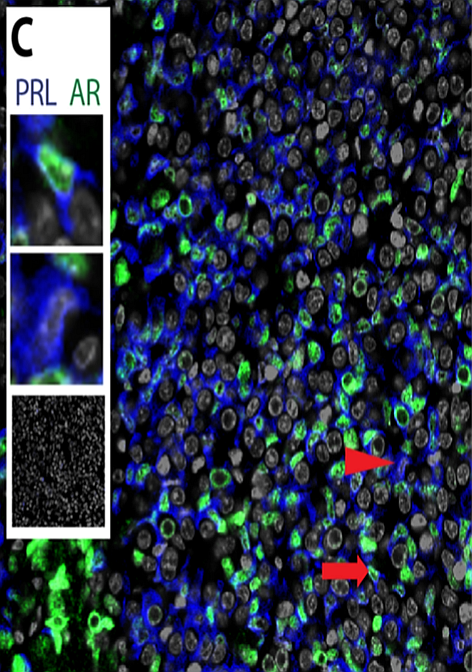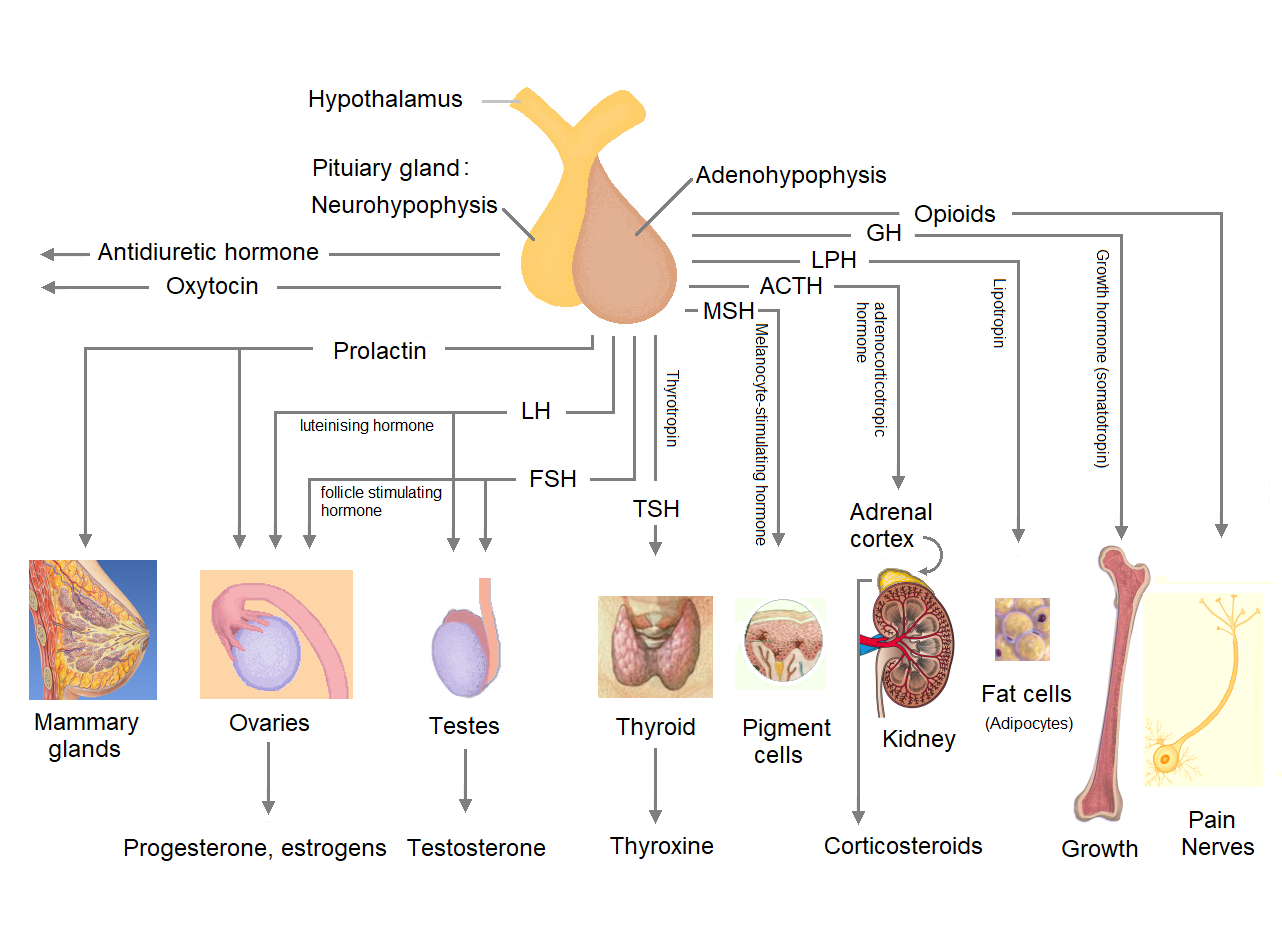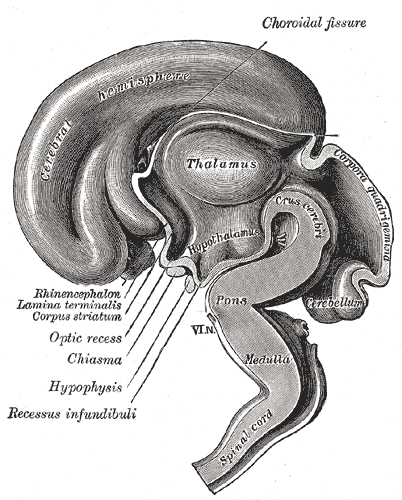|
Prolactin
Prolactin (PRL), also known as lactotropin and mammotropin, is a protein best known for its role in enabling mammals to produce milk. It is influential in over 300 separate processes in various vertebrates, including humans. Prolactin is secreted from the pituitary gland in response to eating, mating, estrogen treatment, ovulation and nursing. It is secreted heavily in pulses in between these events. Prolactin plays an essential role in metabolism, regulation of the immune system and pancreatic development. Discovered in non-human animals around 1930 by Oscar Riddle and confirmed in humans in 1970 by Henry Friesen, prolactin is a peptide hormone, encoded by the ''PRL'' gene. In mammals, prolactin is associated with milk production; in fish it is thought to be related to the control of water and salt balance. Prolactin also acts in a cytokine-like manner and as an important regulator of the immune system. It has important cell cycle-related functions as a growth-, diffe ... [...More Info...] [...Related Items...] OR: [Wikipedia] [Google] [Baidu] |
Prolactin Receptor
The prolactin receptor (PRLR) is a type I cytokine receptor encoded in humans by the ''PRLR'' gene on chromosome 5p13-14. It is the receptor for prolactin (PRL). The PRLR can also bind to and be activated by growth hormone (GH) and human placental lactogen (hPL). The PRLR is expressed in the mammary glands, pituitary gland, and other tissues. It plays an important role in lobuloalveolar development of the mammary glands during pregnancy and in lactation. Structure The prolactin receptor (PRLR) is a membrane-bound protein of the cytokine receptor superfamily. In humans, it is encoded by a single gene which contains 11 exons and is located on chromosome 5. PRLR expression can be found in several tissues such as the gonads, breast, uterus, heart, liver, kidney, brain, immune cells, as well as adrenal and pituitary glands. Several PRLR isoforms have been described in different tissues. These have varying lengths and cytoplasmic domain composition, but share identical extr ... [...More Info...] [...Related Items...] OR: [Wikipedia] [Google] [Baidu] |
Lactotrophs
A prolactin cell (also known as a lactotropic cell, epsilon acidophil, lactotrope, lactotroph, mammatroph, mammotroph) is a cell (biology), cell in the anterior pituitary which produces prolactin (a peptide hormone) in response to hormonal signals including dopamine (which is inhibitory), thyrotropin-releasing hormone and estrogen (especially during pregnancy), which are stimulatory. Prolactin is responsible for actions needed for body homeostasis, the development of breasts, and for lactation. The inhibitory effects of dopamine override the stimulatory effects of TRH in non-pregnant, non-lactating sexually mature females. Depending on the sex of the individual, prolactin cells account for 20% - 50% of all cells in the anterior pituitary gland. Other regulators include oxytocin and progesterone. Males and non-pregnant, non-lactating females typically have low levels of prolactin. The number for prolactin cells in a pregnant female will increase to allow for breast tissue developm ... [...More Info...] [...Related Items...] OR: [Wikipedia] [Google] [Baidu] |
Lactation
Lactation describes the secretion of milk from the mammary glands and the period of time that a mother lactates to feed her young. The process naturally occurs with all sexually mature female mammals, although it may predate mammals. The process of feeding milk in all female creatures is called ''nursing'', and in humans it is also called ''breastfeeding''. Newborn infants often produce some milk from their own breast tissue, known colloquially as witch's milk. In most species, lactation is a sign that the female has been pregnant at some point in her life, although in humans and goats, it can happen without pregnancy. Nearly every species of mammal has teats; except for monotremes, egg-laying mammals, which instead release milk through ducts in the abdomen. In only a handful of species of mammals, certain bat species, is milk production a normal Male lactation, male function. ''Galactopoiesis'' is the maintenance of milk production. This stage requires prolactin. Oxytocin is cr ... [...More Info...] [...Related Items...] OR: [Wikipedia] [Google] [Baidu] |
Pituitary Gland
The pituitary gland or hypophysis is an endocrine gland in vertebrates. In humans, the pituitary gland is located at the base of the human brain, brain, protruding off the bottom of the hypothalamus. The pituitary gland and the hypothalamus control much of the body's endocrine system. It is seated in part of the sella turcica a fossa (anatomy), depression in the sphenoid bone, known as the hypophyseal fossa. The human pituitary gland is ovoid, oval shaped, about 1 cm in diameter, in weight on average, and about the size of a kidney bean. Digital version. There are two main lobes of the pituitary, an anterior pituitary, anterior lobe, and a posterior pituitary, posterior lobe joined and separated by a small intermediate lobe. The anterior lobe (adenohypophysis) is the glandular part that produces and secretes several hormones. The posterior lobe (neurohypophysis) secretes neurohypophysial hormones produced in the hypothalamus. Both lobes have different origins and they are both co ... [...More Info...] [...Related Items...] OR: [Wikipedia] [Google] [Baidu] |
Hypothalamus
The hypothalamus (: hypothalami; ) is a small part of the vertebrate brain that contains a number of nucleus (neuroanatomy), nuclei with a variety of functions. One of the most important functions is to link the nervous system to the endocrine system via the pituitary gland. The hypothalamus is located below the thalamus and is part of the limbic system. It forms the Basal (anatomy), basal part of the diencephalon. All vertebrate brains contain a hypothalamus. In humans, it is about the size of an Almond#Nut, almond. The hypothalamus has the function of regulating certain metabolic biological process, processes and other activities of the autonomic nervous system. It biosynthesis, synthesizes and secretes certain neurohormones, called releasing hormones or hypothalamic hormones, and these in turn stimulate or inhibit the secretion of hormones from the pituitary gland. The hypothalamus controls thermoregulation, body temperature, hunger (physiology), hunger, important aspects o ... [...More Info...] [...Related Items...] OR: [Wikipedia] [Google] [Baidu] |
Estrogen
Estrogen (also spelled oestrogen in British English; see spelling differences) is a category of sex hormone responsible for the development and regulation of the female reproductive system and secondary sex characteristics. There are three major endogenous estrogens that have estrogenic hormonal activity: estrone (E1), estradiol (E2), and estriol (E3). Estradiol, an estrane, is the most potent and prevalent. Another estrogen called estetrol (E4) is produced only during pregnancy. Estrogens are synthesized in all vertebrates and some insects. Quantitatively, estrogens circulate at lower levels than androgens in both men and women. While estrogen levels are significantly lower in males than in females, estrogens nevertheless have important physiological roles in males. Like all steroid hormones, estrogens readily diffuse across the cell membrane. Once inside the cell, they bind to and activate estrogen receptors (ERs) which in turn modulate the expression of many ... [...More Info...] [...Related Items...] OR: [Wikipedia] [Google] [Baidu] |
Arcuate Nucleus
The arcuate nucleus of the hypothalamus (ARH), or ARC, is also known as the infundibular nucleus to distinguish it from the arcuate nucleus of the medulla oblongata in the brainstem. The arcuate nucleus is an aggregation of neurons in the mediobasal hypothalamus, adjacent to the third ventricle and the median eminence. The arcuate nucleus includes several important and diverse populations of neurons that help mediate different neuroendocrine and physiological functions, including neuroendocrine neurons, centrally projecting neurons, and astrocytes. The populations of neurons found in the arcuate nucleus are based on the hormones they secrete or interact with and are responsible for hypothalamic function, such as regulating hormones released from the pituitary gland or secreting their own hormones. Neurons in this region are also responsible for integrating information and providing inputs to other nuclei in the hypothalamus or inputs to areas outside this region of the brain. T ... [...More Info...] [...Related Items...] OR: [Wikipedia] [Google] [Baidu] |
Anterior Pituitary
The anterior pituitary (also called the adenohypophysis or pars anterior) is a major Organ (anatomy), organ of the endocrine system. The anterior pituitary is the glandular, Anatomical terms of location#Usage in human anatomy, anterior lobe that together with the posterior pituitary (or neurohypophysis) makes up the pituitary gland (hypophysis) which, in humans, is located at the base of the Human brain, brain, protruding off the bottom of the hypothalamus. The anterior pituitary regulates several physiological processes, including stress (medicine), stress, Human development (biology), growth, reproduction, and lactation. Proper functioning of the anterior pituitary and of the organs it regulates can often be ascertained via blood tests that measure hormone levels. Structure The pituitary gland sits in a protective bony enclosure called the sella turcica (''Turkish chair/saddle''). It is composed of three lobes: the anterior, intermediate, and posterior lobes. In many animals, ... [...More Info...] [...Related Items...] OR: [Wikipedia] [Google] [Baidu] |
D2 Receptor
Dopamine receptor D2, also known as D2R, is a protein that, in humans, is encoded by the ''DRD2'' gene. After work from Paul Greengard's lab had suggested that dopamine receptors were the site of action of antipsychotic drugs, several groups, including those of Solomon H. Snyder and Philip Seeman used a radiolabeled antipsychotic drug to identify what is now known as the dopamine D2 receptor. The dopamine D2 receptor is the main receptor for most antipsychotic drugs. The structure of DRD2 in complex with the atypical antipsychotic risperidone has been determined. Function D2 receptors are coupled to Gi subtype of G protein. This G protein-coupled receptor inhibits adenylyl cyclase activity. In mice, regulation of D2R surface expression by the neuronal calcium sensor-1 (NCS-1) in the dentate gyrus is involved in exploration, synaptic plasticity and memory formation. Studies have shown potential roles for D2R in retrieval of fear memories in the prelimbic cortex and in ... [...More Info...] [...Related Items...] OR: [Wikipedia] [Google] [Baidu] |
Progesterone
Progesterone (; P4) is an endogenous steroid and progestogen sex hormone involved in the menstrual cycle, pregnancy, and embryogenesis of humans and other species. It belongs to a group of steroid hormones called the progestogens and is the major progestogen in the body. Progesterone has a variety of important functions in the body. It is also a crucial metabolic intermediate in the production of other endogenous steroids, including the sex hormones and the corticosteroids, and plays an important role in brain function as a neurosteroid. In addition to its role as a natural hormone, progesterone is also used as a medication, such as in combination with estrogen for contraception, to reduce the risk of Uterine cancer, uterine or cervical cancer, in hormone replacement therapy, and in feminizing hormone therapy. It was first prescribed in 1934. Biological activity Progesterone is the most important progestogen in the body. As a potent agonist of the progesterone receptor, nu ... [...More Info...] [...Related Items...] OR: [Wikipedia] [Google] [Baidu] |
Peptide Hormone
Peptide hormones are hormones composed of peptide molecules. These hormones influence the endocrine system of animals, including humans. Most hormones are classified as either amino-acid-based hormones (amines, peptides, or proteins) or steroid hormones. Amino-acid-based hormones are water-soluble and act on target cells via second messenger systems, whereas steroid hormones, being lipid-soluble, diffuse through plasma membranes to interact directly with intracellular receptors in the cell nucleus. Like all peptides, peptide hormones are synthesized in cell (biology), cells from amino acids based on Messenger RNA, mRNA transcripts, which are derived from DNA templates inside the cell nucleus. The initial precursors, known as preprohormones, undergo processing in the endoplasmic reticulum. This includes the removal of the N-terminal signal peptide and, in some cases, glycosylation, yielding prohormones. These prohormones are then packaged into secretory vesicle (biology), vesicles, ... [...More Info...] [...Related Items...] OR: [Wikipedia] [Google] [Baidu] |
Henry Friesen
Henry George Friesen (July 31, 1934 – April 30, 2025) was a Canadian endocrinologist, a distinguished professor emeritus of the University of Manitoba and the discoverer of human prolactin, a hormone which stimulates lactation in mammary glands. Biography Born in Morden, Manitoba, he obtained a Bachelor of Science in medicine and a medical degree from the University of Manitoba in 1958. From 1965 to 1973 he was at McGill University and from 1973 to 1992 he was a professor and head of the department of physiology and professor of medicine at the University of Manitoba. Friesen was a recipient of the 1977 Canada Gairdner International Award "In recognition of his contributions to the understanding of the biochemistry, physiology and pathophysiology of lactogenic hormones and, in particular, for the identification of human prolactin." His research on growth hormones in dwarf children helped in developing a therapy for the treatment of this problem. In addition his work with p ... [...More Info...] [...Related Items...] OR: [Wikipedia] [Google] [Baidu] |







